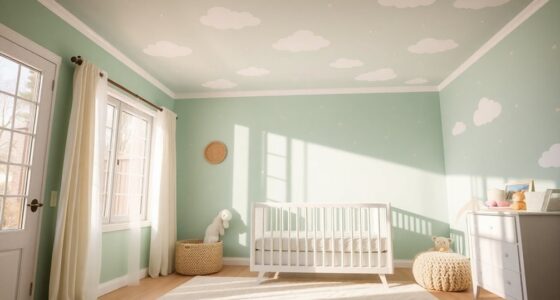Imagine coming home after a tiring day to a bedroom filled with soothing colors. These colors wrap around you, making the room feel like a safe haven. In our busy lives, the colors of our bedrooms can help calm our minds and make sleep better.
Finding the right colors for your bedroom is more than making it look good. It’s about taking care of your health and setting the mood for relaxation. Let’s dive into how color affects our sleep and uncover the best shades for a restful night.
Key Takeaways
- The color blue has been shown to promote the longest sleep duration, averaging about 8 hours.
- Warm colors like yellow and orange can energize but may reduce sleep quality compared to cooler tones.
- Green shades promote calmness, making them another excellent choice for restful sleep.
- Using calming bedroom colors can significantly improve your mood and atmosphere.
- The psychology of colors impacts our emotions, influencing our sleep quality and overall well-being.
- Choosing the right colors is essential for creating a therapeutic environment in your bedroom.
- Beige and gray shades contribute to a cozy and clean sleeping space that enhances relaxation.
The Importance of Color in Your Bedroom
Choosing the right bedroom colors is crucial for your sleep. The right colors can make you feel relaxed, comfortable, and peaceful. Knowing how color affects your bedroom can turn it into a calming sleep haven.
Experts in color psychology say certain colors can calm us or keep us awake. For example, blue is great for sleep because it’s calming. It makes us feel safe, which helps us sleep better. But bright colors like red and yellow can make it hard to relax.
Soft colors like greens and light purples can make your bedroom feel positive and calm. They make you feel good and help you think clearly, which is great before bed. But using too much dark color might make you feel uneasy or not care, so be careful.
Remember, color in your bedroom is very important for good sleep. Choose colors that make you feel comfortable. This will help turn your bedroom into a calm place where you can sleep well.
How Color Affects Sleep Quality
Color affects your mood and changes how well you sleep. Studies show the color impact on sleep is huge. Blue and soft hues help you relax. They are great for making your bedroom a peaceful space. Bedrooms painted blue offer more sleep than those in other colors. This calming shade lowers your heart rate and blood pressure, surrounding you with peace.
Vibrant colors like red and yellow wake you up and mess with your sleep. Warm colors keep your mind active, which isn’t good if you want to sleep well. Red, linked with anger and stress, increases your blood pressure and heart rate. It’s a bad choice for bedrooms. Dark colors, including black and brown, might make you feel sad or anxious, hurting your sleep quality.
Bright colors make us feel happier than dark ones do. Light blue feels more cheerful than dark yellow. Knowing how colors make us feel helps us pick relaxing colors for our bedrooms. Using calming shades like deep green or soft pink adds warmth. It makes a big difference in improving your sleep.
| Color | Emotional Impact | Effect on Sleep |
|---|---|---|
| Blue | Calm, Tranquil | Promotes longer sleep |
| Red | Aggressive, Exciting | Disrupts sleep patterns |
| Black | Intense, Somber | Can evoke anxiety |
| Green | Relaxing, Comfortable | Supports calmness |
| Blush Pink | Warm, Calming | Enhances relaxation |
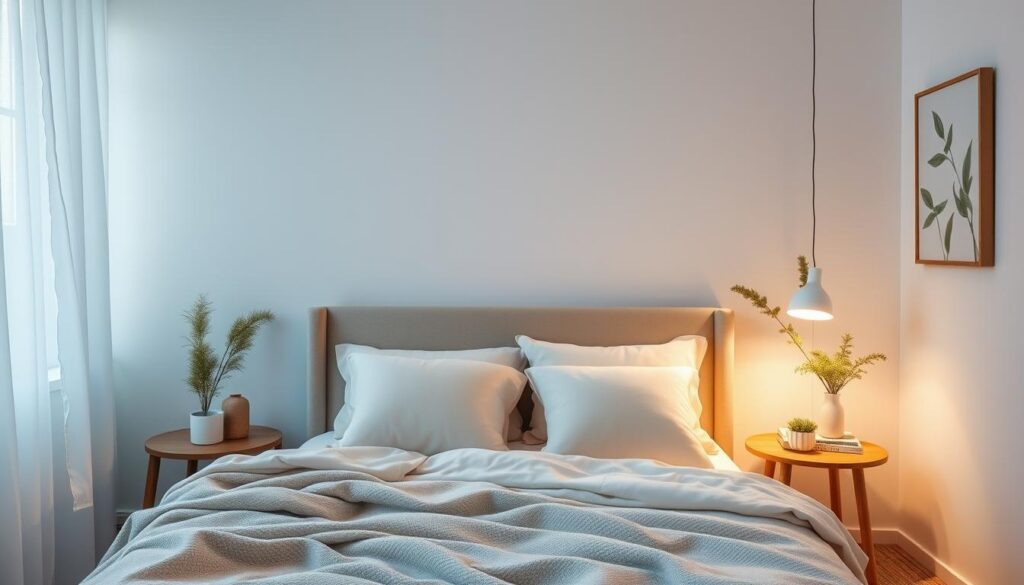
Understanding Color Psychology
Color psychology studies how colors affect our feelings and actions. This is especially true in personal spaces like bedrooms. Knowing how colors impact us can help make a room feel restful and fresh. Every color has unique traits that stir different emotions, affecting our wellbeing.
Emotional Responses to Color
Colors lead to specific feelings and change how we act. For example:
- Soft blue calms us, making us feel peaceful and relaxed.
- Pale green brings harmony and balance, creating a caring space.
- Pastel pink offers comfort and kindness, helping us sleep better.
- Neutral tones like beige and ivory help us unwind, giving us freedom in decorating.
- Light gray adds elegance while keeping things calm.
- Soft whites symbolize purity and simplicity, ensuring a peaceful bedroom atmosphere.
- But, bright colors like red, purple, and orange can make it hard to relax.
The Science Behind Chromatics
Chromatics, the study of color, looks at how colors impact us. Research finds that cool tones like blue and green help calm us by lowering our heart rate. On the other hand, warm colors might make us feel lively but also a bit overwhelmed. It’s important to test paint colors in your room since lighting can change how they look. Having colors that flow well together makes a room more pleasant. Using bold colors as accents helps keep the space balanced.
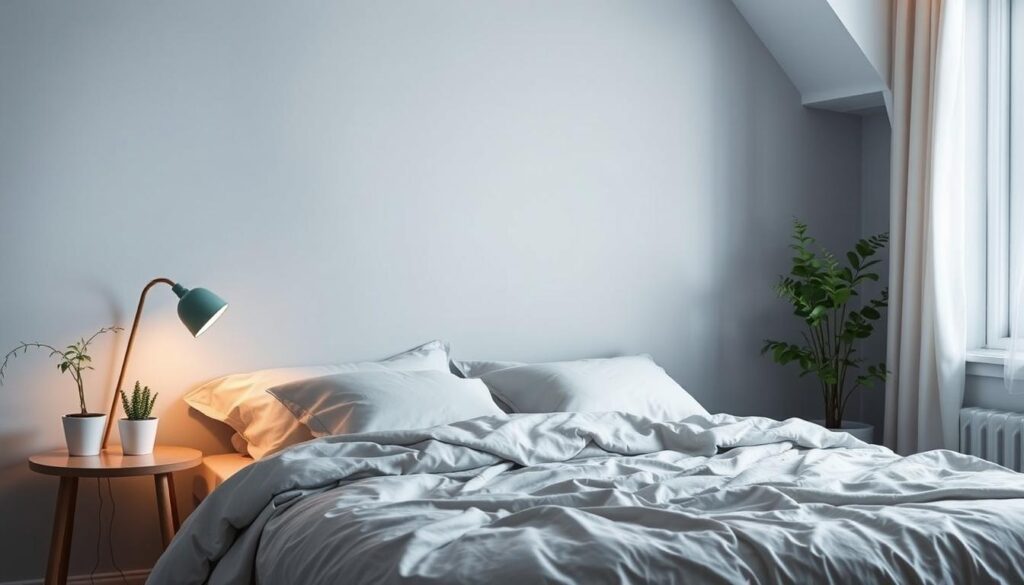
Talking to an interior designer can give you personalized advice for your room. The right colors can make your bedroom a perfect spot for relaxation and peace.
| Color | Emotional Response | Benefits | Drawbacks |
|---|---|---|---|
| Soft Blue | Calmness, tranquility | Promotes peace and relaxation | Can feel too cold in some settings |
| Pale Green | Harmony, balance | Nurtures a comforting environment | May appear dull if overused |
| Pastel Pink | Comfort, compassion | Supports restful sleep | Can feel gender-specific |
| Neutral Tones | Versatility | Enhances relaxation and expression | Risk of being overly bland |
| Red | Energy | Higher blood pressure and heart rate | Too stimulating for relaxation |
| Light Gray | Calmness | Adds sophistication | May lack vibrancy |
| Soft Whites | Purity, clarity | Creates a timeless and harmonious space | Can feel sterile if overused |
Why You Should Choose the Right Color
Choosing the right color for your bedroom is very important. It helps create a calm space where you can sleep well. The importance of color choice is huge because some colors make us feel happy, while others can make us anxious.
Studies show blue is the best color for bedroom walls. It can help you feel calm and sleep better. Blue light affects specific cells in our eyes, helping adjust our body clocks.
Green and soft yellows are also good because they’re calming. But purples might make the room too lively, which isn’t great for sleep. Greys are calming too and they add a stylish touch, so they’re a smart pick for anyone.
Using one color in different shades keeps the room peaceful. This monochrome look is soothing. Lighter colors, like pastels, can also make your bedroom look nice without being too much.
Colors affect how we feel. Warm colors energize, but cool colors help us relax. So, picking the right colors for your bedroom can influence how you feel and sleep.
Knowing how to use colors helps make your bedroom a peaceful and welcoming place. Here’s a list of good colors to think about for your bedroom makeover:
| Color | Effect on Sleep | Recommendation |
|---|---|---|
| Blue | Promotes calmness | High |
| Green | Encourages relaxation | Moderate |
| Yellow | Creates a sense of joy | Moderate |
| Purple | May energize | Low |
| Grey | Instills calmness | High |
| Pastels | Enhances relaxation | High |
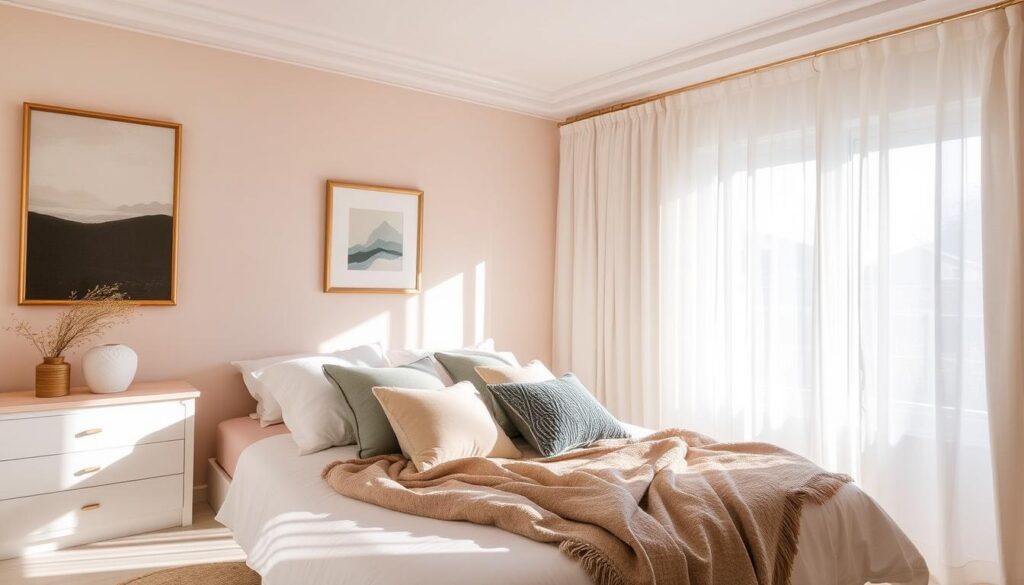
Spending time to pick the right colors will turn your bedroom into a sanctuary. It’s all about finding a place where you can truly relax and recharge.
The Best Bedroom Colors for Sleep
Creating the perfect sleep setting often starts with color choice. Different colors affect how you feel and relax. Blue is the best for sleep quality among all colors.
Blue: The Top Choice for Tranquility
A blue bedroom is a top pick for those wanting calm. People in blue rooms sleep better and feel more refreshed. Blue is known to relax the mind and make you feel peaceful.
Why Blue Promotes Better Sleep
Science supports blue’s sleeping perks. Some eye receptors love blue, causing hormones that improve sleep. This lowers stress and anxiety, making blue a top bedroom color.
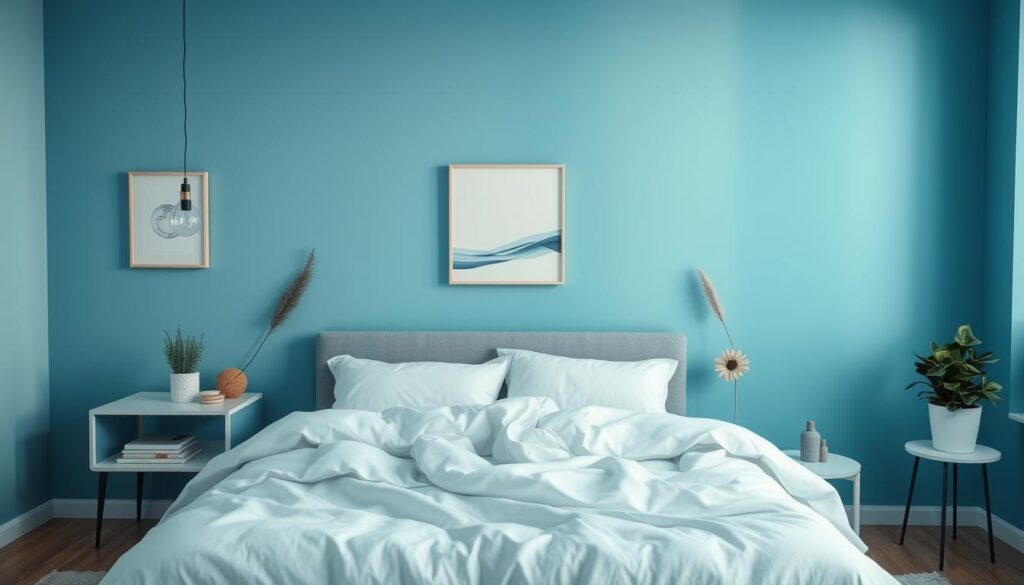
Unlike bright colors like red or yellow, blue is calming. Since a third of folks with beige walls sleep poorly, picking the right color is essential. Choosing blue or similar soothing colors creates a restful haven.
| Color | Effect on Sleep | Popularity |
|---|---|---|
| Blue | Promotes relaxation and tranquility | High |
| Beige | Linked to poor sleep quality | Moderate |
| White | Mixed results; some report sleep issues | Most popular |
| Red/Yellow/Orange | Too stimulating; may increase heart rates | Low |
| Pale Lavender | Relaxing and calming effect | Moderate |
Other Great Options for Bedroom Colors
Picking the right color for your bedroom can really affect how you feel. Some colors stand out because they’re not only beautiful but also create a peaceful space. Each color has unique qualities that make them great for different tastes.
Yellow: Happiness in Your Space
A yellow bedroom, especially in softer shades, makes a cheerful bedroom full of warmth and joy. Studies show people sleep well in yellow rooms. This inviting color makes your room cozy, perfect for starting the day right.
Green: Nature’s Calm
The green bedroom color brings the peace of nature inside, making you feel refreshed. Calming green shades turn your bedroom into a soothing escape. Colors like Mossy Green or Light Sage create a calm space that helps you sleep better.
Silver: A Peaceful Neutral
If you’re looking for sophistication, a silver color for bedrooms is a calm, neutral choice. Silver tones go well with different styles and help make a space peaceful for sleeping. It’s a balanced color, letting other parts of your room stand out without being too bold.
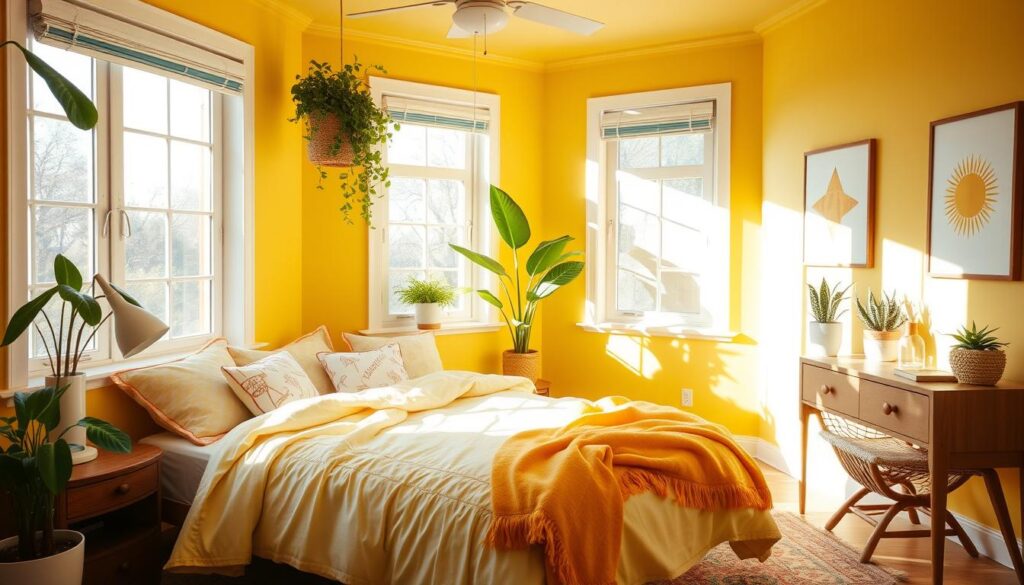
Vibrant Colors That Support Sleep
Using bright colors in your bedroom can make it cozy and ready for sleep. Orange is a unique color that is not used often but is very promising. With the right shades of orange, your room can feel warm and inviting, perfect for relaxing at the end of the day.
Orange: A Warm Embrace
Orange, especially in soft or earthy tones, brings warmth and comfort. It makes your bedroom welcoming and helps reduce stress to relax better. Warm colors are good for sleep because they make the space feel cozy. Orange is an excellent choice for making your color theme stand out.
Here are some reasons to choose an orange color for your bedroom:
- Inviting Environment: Orange adds warmth, making the room feel friendly and inviting.
- Energetic Yet Soothing: This vibrant color creates a lively yet not too bold background, giving the room a balanced feel.
- Ideal for Accents: If you like neutral or light colors, adding orange accents can spice up the space without overwhelming it.
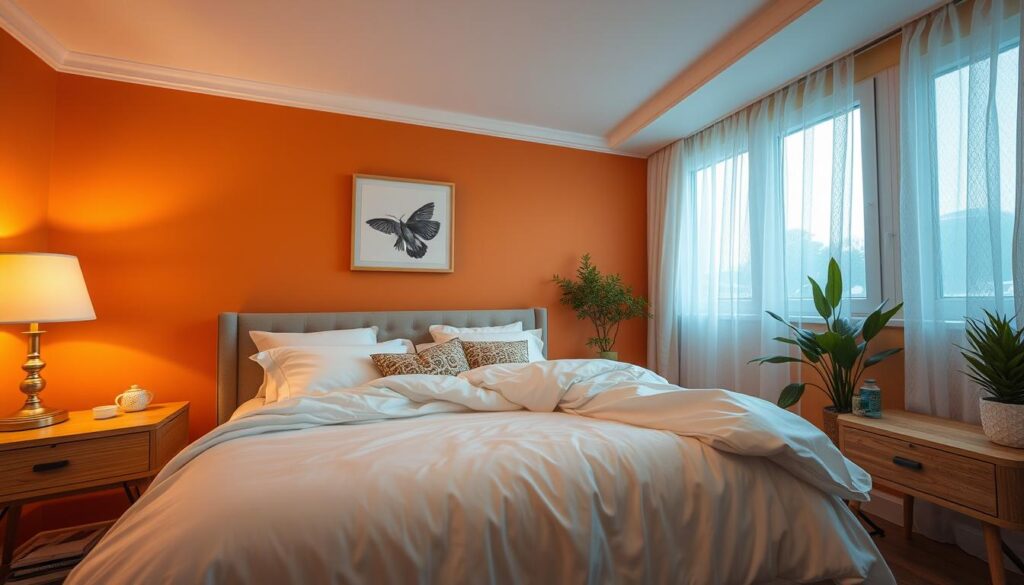
Orange is a great choice when picking lively colors for relaxation. Choosing the right shades of orange makes your space feel both energetic and peaceful. It helps in getting a good night’s sleep.
Understanding Color Temperature
Color temperature is key in shaping how we see light and its effect on us. It tells us if colors look warm or cool. Warm colors like reds and oranges make a place feel cozy. Cool colors, such as blues and greens, bring a refreshing feel. Knowing how color temperature affects sleep helps in setting up your bedroom for better health.
Light bulbs vary in color temperature, ranging from 2700K to 6500K. Warm light, at 2700K, is similar to the gentle shine of a sunset. It encourages a sense of calm, perfect for bedrooms. On the other hand, cooler light at 6500K looks bluish-white. It can make us feel more awake, which is not great for sleep.
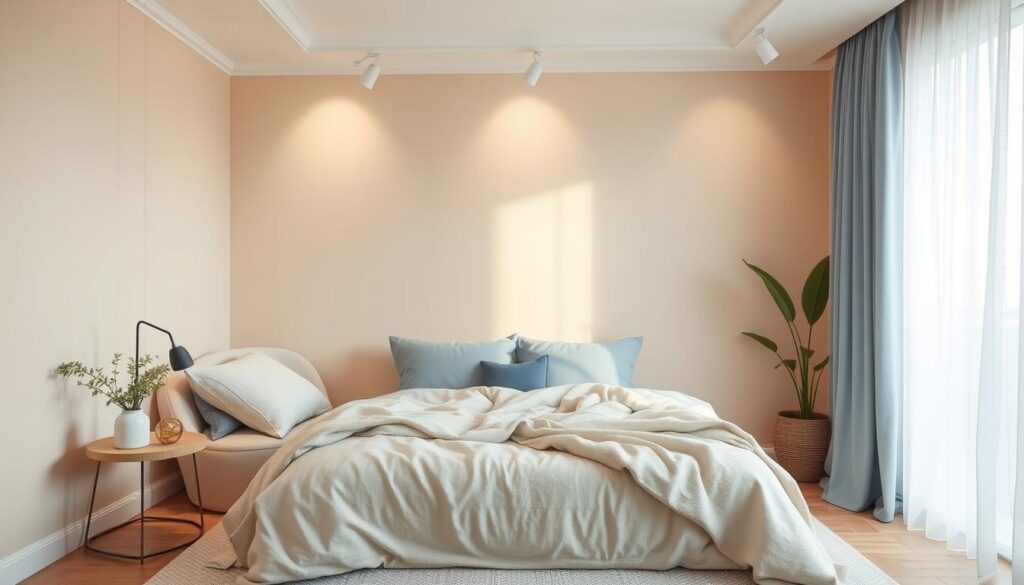
For bedroom lighting, we divide color temperatures into three main types:
- Warm White (2700K-3000K): Creates a calming and cozy feel.
- Yellow Warm Light (3500K): Good for both relaxing and working.
- Neutral White (4000K): Brighter light, best for tasks.
At night, warmer light is best. It helps our bodies get ready to rest. In the morning, neutral white light helps us wake up and get moving.
Using a mix of general, task, and accent lighting makes a room work better. It lets you:
- General lighting (2700K-3000K)
- Task lighting (2700K-4000K)
- Accent lighting with different sources
Smart lighting systems let you change the light’s color temperature. This means you can adjust your room’s feel based on what you’re doing or your mood. It makes for a more comfy and restful bedroom.
Best Bedroom Colors: Finding Your Shade
Finding the perfect color for your bedroom is very important. It helps create a peaceful space. Muted colors make a room feel calm, but bright colors might keep you awake. Choose colors that help you relax, making your bedroom a great place to sleep.
Muted vs. Bright Colors
Experts say to stay away from bright colors like red or bold yellow in bedrooms. These colors can make it hard to relax. On the other hand, cool shades like blue and green help calm you down. It’s all about finding the right mix between soft and lively colors for good sleep.
Choosing Your Color Palette
Think about how different colors go together when choosing for your bedroom. Mix muted tones with a few brighter spots for a welcoming feel. Try out paint samples on your walls to see how light changes their look during the day. Your goal is to find colors that make your space peaceful for better relaxation at night.
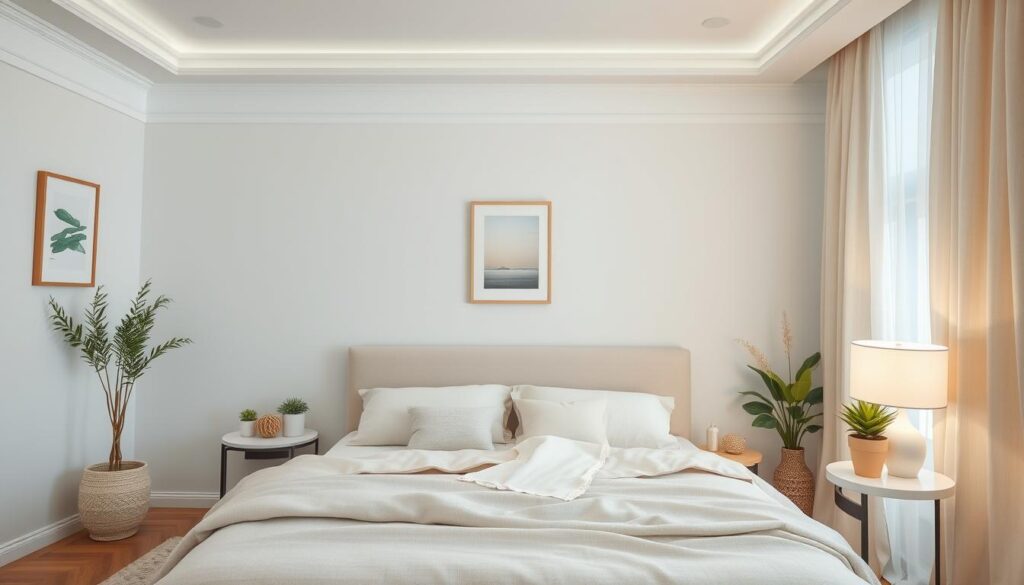
| Color Type | Example Colors | Effect on Sleep |
|---|---|---|
| Muted Colors | Soft Blue, Lavender, Sage Green | Promote calmness and tranquility |
| Bright Colors | Bright Yellow, Bold Orange | Can increase stress and heart rates |
| Warm Neutrals | Creamy White, Soft Gray | Create a cozy atmosphere |
| Accent Colors | Navy Blue, Terracotta | Add depth without overwhelming |
Conclusion
The colors you pick for your bedroom are key in making your sleep better and your room more relaxing. The top trends for 2025 suggest using natural colors. This includes earthy greens like sage and eucalyptus, and calm blues like dusty blue and soft aqua. These colors help turn your room into a calm place that helps you sleep well.
Warm neutrals, soft pinks, and terracotta shades also make your room feel cozy without being too much. When you choose colors from brands like Benjamin Moore and Sherwin-Williams, you’re doing more than improving sleep. You’re also showing your unique style. Pairing sage green with cream, or dusty blue with white, can make your room look good and feel peaceful.
Choosing colors you love is really important; they should make you feel comfortable and happy. Use colors to bring out certain feelings and make your bedroom a peaceful place. This helps make sure your nights are as restful as they can be.





